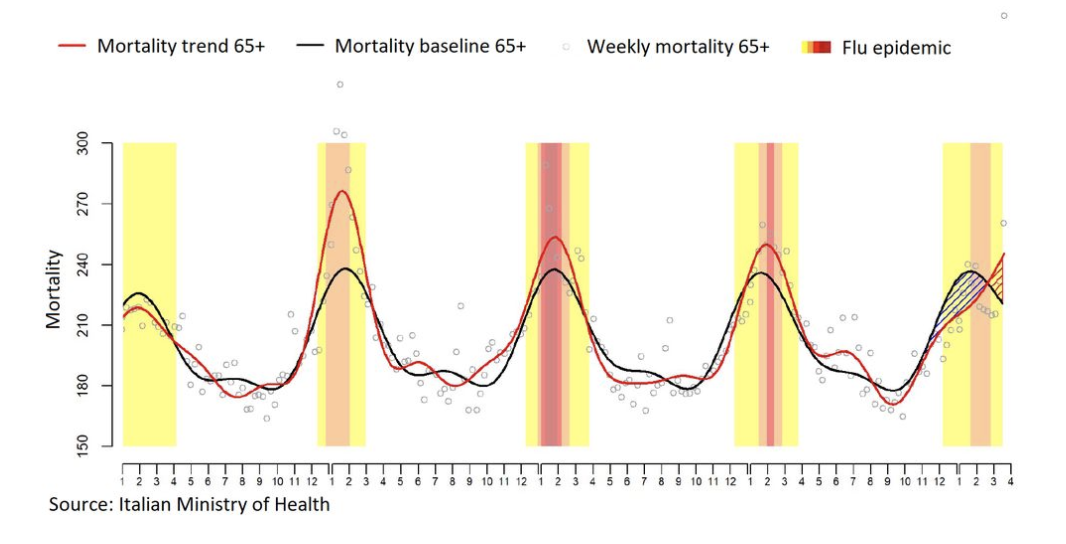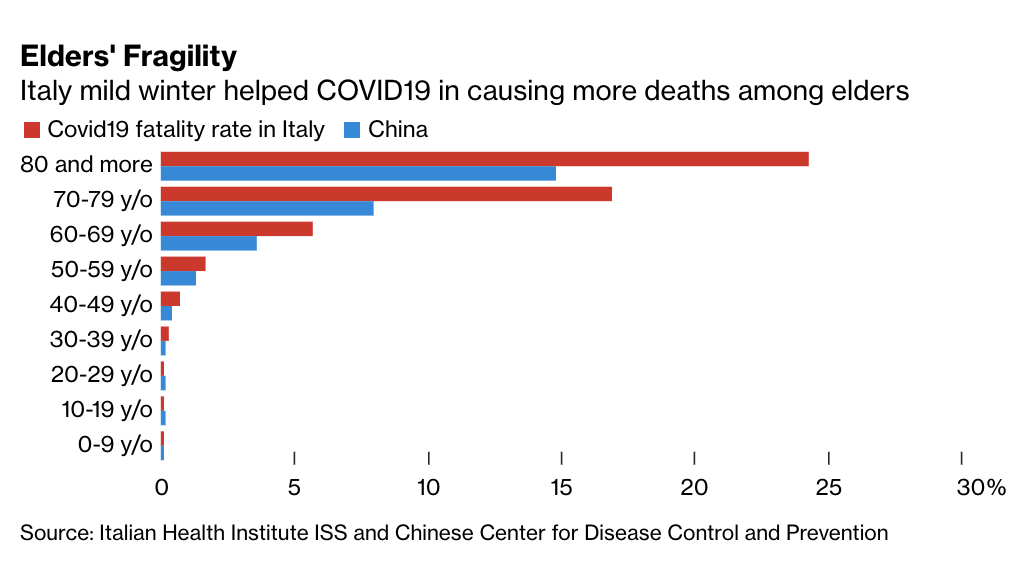10%にもなるイタリアの武漢肺炎致死率の背景
世界的パンデミックの中でイタリアの致死率が10%にもなるというのは不可解な驚きだ。イタリアの致死率はドイツ(0.4%)のx20にもなる、また中国(2.5%)の何倍にもなる。
As scientists puzzle over the reason, researchers have proposed a theory that's being vetted by peers: Italy's mild flu season left a larger victim pool for COVID-19. This would suggest that the US, which has struggled with more lethal flu seasons, won't have as large a pool of potential high-risk victims, especially as testing suggests the virus is more widespread than many had expected.
科学者たちはこの理由に悩んできた、研究者は同僚の批判にも耐えうる理論を提案した:イタリアでは今年季節性インフルエンザが穏やかだったために、武漢肺炎犠牲者が大きくなった。(訳注:いつもならインフルエンザで亡くなるはずの人が今年は武漢コロナで亡くなっている)ということは米国では今年インフルエンザが猛威を奮っており、潜在的犠牲者であるハイリスクのひとがそれほど多く残されていない、特に検査の結果が示唆するところでは多くの人が予想するよりも遥かに多くの人が武漢コロナに感染している。

A report by the Italian Ministry of Health found that elderly people and those with chronic diseases who were spared death by the flu from November through January are "outsize" targets for the more lethal novel coronavirus in March.
イタリア保健省の報告では、本来なら11月から1月の間にインフルエンザで亡くなるはずの高齢で基礎疾患を持つ人達が、3月により致死性の高い武漢肺炎の「カッコウの目標」となってしまった。
今年はインフルエンザによる死者がほとんど居なかったために、この「最も脆弱な人が多量に待ち構えていた、」と報告書で述べている、3月21日までのイタリアの19都市のデータを分析しての結果だ。言い換えると、このインフルエンザ流行で亡くなる人が増える時期に、武漢肺炎流行と格闘する先進国においては、通常よりも突出して死者が増えてしまった。
COVID-19 has been spreading in some parts of Italy since early February. In the northern cities that have borne the brunt of Italy’s more than 12,000 deaths, flu mortality among people age 65 and over was 6% below a baseline from previous years. In the cities of central and southern Italy, flu deaths were 3% off the baseline.
イタリアでは2月初めから武漢肺炎が流行した。北部の都市では12,000人もの死者を出すなかで、65歳超のインフルエンザ死者数は前年ベースラインよりも6%以上少なかった。イタリア中央・南部都市では、インフルエンザ死者数はベースラインよりも3%少ない。
Could this account for enough deaths? It's possible that it could account for at least some of the discrepancy.
これで死者数の説明が十分だろうか?多少の食い違いはあるかもしれないが、説明としては十分だろう。
A chart shows how deaths among the 65-plus population during the coronavirus outbreak through March 21 has already reached the levels of the previous two flu seasons, and were still below the total flu season deaths from three seasons ago (the 2016-2017 season).
下のチャートが死亡状況を示している、3月21日までの武漢コロナ流行による65歳超の人の死亡数はすでにこれまでの2回のインフルエンザ流行期のレベルに達している、これでもまだ3季節前のインフルエンザ死者よりも少ない(2016−2017の流行期だ)。

今年は温暖だったためにインフルエンザ死者が少なかった。

Understanding the history of Italy's flu outbreaks could hold the key to explaining its outlandish mortality rate from COVID-19. Italy has reported more than 105,000 confirmed cases, along with 12,428 deaths.
イタリアにおけるインフルエンザ流行の歴史を理解することが重要だ、これを理解すると武漢コロナによる異様な死亡率を説明できる。イタリアの確定患者は105,000で12,428人が亡くなっている。




